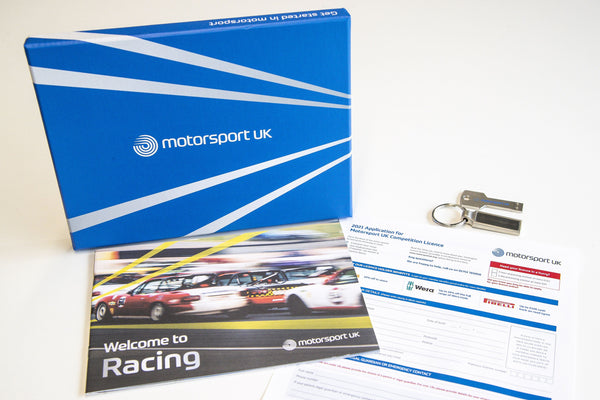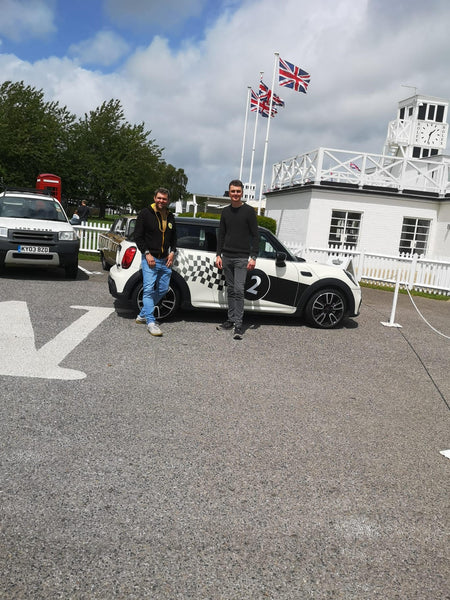
How To Pass Your ARDS Test in 2022 - A Guide
Author: Tom Magnay / Images: BlendLine Magazine
A few weeks ago, as those who listen to the Gobble De-Clutch podcast will know, I undertook (and - plot spoiler - passed) my ARDS (Association of Racing Driver Schools) racing licence test at Goodwood Motor Circuit.
It is something that I had promised myself I would do, along with my fellow podcast host Sion Ellis of Automax.
Whilst both of us have held BARS (British Association of Rally Schools) rally licences for some years now, and this has enabled us both to compete in, obviously, rally events but also branch out into rallycross (Sion) and speed hillclimb (yours truly) we have both been restricted on entering race events due to not holding the Racing category on our licences. So we both saw it as an upgrade and for both of us, a new challenge.

Both being Goodwood members, it did make sense to do our test at that venue, however you can take an ARDS test at many circuits right up and down the country.
Here's a rundown of the process required to take your test.
- First, you will need to order a Motorsport UK ARDS pack which contains the all important form (which you need to take to your exam) as well as the whole MSUK Blue Book (yearbook) and a helpful video on things to revise for both the written and practical elements of the test. You can buy one of these, here.

- Then you will need to contact a racing circuit and book an ARDS test. This can be done at Knockhill in Scotland, right down to Brands Hatch in the south east, with many location in between, so you are never normally more than a few hours away from your local ARDS test venue.
- Once you have booked your ARDS test, you will need to revise for both parts of the test but especially the written exam. This part of your test comprises of flag knowledge (this part you have to get 100% correct) and also a series of scenarios which have multiple choice answers, this also requires most answers to be correct in order to pass. I personally put a lot of effort in the weeks before hand in to getting this lot right, I did quite a bit of prep beforehand to make sure I wouldn't fail here due to a rookie error, or interpreting the question wrong. You're allowed about 20 minutes in the test and I used every minute wisely to make sure I had filled it all in correctly! Someone in our small group of four participants did fail and I didn't want to be joining him!

- Each ARDS venue will conduct their day differently, at Goodwood (they pride themselves on having smaller groups and a much more personal vibe) after our written exam we were sent off into their circuits own fleet of Mini Cooper cars with pro instructors with us. This was one-to-one and we really had a good amount of seat time to get used to the car, the instructor and what was expected of us from this part of the test. Again, every circuit does this differently, at MSV tracks the price of the ARDS test is around half that of Goodwood but you don't get the same amount of seat time.

- Speaking of the circuit, we had undertaken an additional challenge here, as neither Sion or I had driven Goodwood circuit before, meaning we also had to learn that, pretty rapidly. One crucial thing about the ARDS exam is that you are expected to commit to the proper racing lines, as well as navigate other traffic on track (both faster and slower moving). Our instructors openly said that we had taken a big risk by doing our test at a circuit we had ever driven at before, and to that end I would recommend getting seat time at your chosen track, unlike what we had done! Goodwood is a very fast and wide circuit, and 'out the back' you really are motoring on, committing in sometimes blind turn in points and apexes (through the rapid, long, right-hander Fordwater and towards St Mary's) and in excess of 100mph through the kinks on the Lavant Straight. I mentioned traffic before, well ALL the other cars on track were faster than our Minis, so it was all about keeping an eye on the mirrors and your etiquette with blue flag situations (you can read all about the importance of this in your MSUK booklet and yearbook). You are watched like a hawk by your instructor on this matter, so you need to make sure you are safe on track around other cars.
- The main thing the instructor looks for in you, during the test is, "am I happy to share a racing track with this person?" If the answer is no, you're going to fail, it's really as simple as that. Goodwood also make a point of not wanting to be the ones who gave someone a racing licence who went on to cause a massive shunt at their first race - and rightly so - they make sure the proper racing standards are met.

- At this point, having done the practice sessions in the car and then going into the 15 minute test (during which you have to do 2 perfect laps of the circuit with no intervention from the instructor - now examiner) we still didn't know if we had passed the written exam that we had sat earlier that morning, so the doubt was still lingering that we might not be going away with a freshly upgraded licence. You are expected to go as fast as possible within the realms of safety (I would say 85% pace is recommended). During my circuit test, I went into Lavant Corner carrying a little too much pace and suffered a classic bit of understeer on the way out, squealing the Pirellis on the front of the Mini but the crucial point to note here, is remaining calm in a situation like this, and controlling the car smoothly out of the error, is exactly what the examiner is looking for, and I lost no marks in my overall scoring owing to my small moment, it was merely noted afterwards that it had earned me (half) a brownie point.
- Don't try and do that, though...
- On the way back to the pitlane, my examiner told me I had passed, which was a great relief as it had been an intense few laps, on a hot afternoon, I'd even had to dig out my racing gloves earlier in the day, as my hands were sweating that badly (I was dead nervous beforehand) that I was losing grip on the steering wheel into the chicane, something I have never had happen before!

- With that part passed (but still not knowing about the results of the written test) it was back to the race control building for an excellent hot lunch and a well earned coffee. There was a painstaking wait of about an hour (it felt like six) while the papers were marked up and we all had lunch. Then we went into the exam room to be handed our papers which I'm glad to say were both passed with flying colours for both Sion and myself. The lead instructor stamped our application forms and congratulated us, and I have to say this was a great feeling given the amount of time it had taken to get to this point - the day had been cancelled once earlier in the year due to the pandemic.


- Another thing that needs doing for racing licences, which is not required for rally licences, is an eye test for all applicants, so we made sure this was done beforehand at a local optician. The optician then marks your eyesight scoring that MSUK have asked for, on your application form. Applicants over the age of 60 will also have to have a full doctors medical. Everyone else just does a self-declaration of health.
- With that done, just post your complete form back to Motorsport UK HQ and they will do the rest and send back your shiny new competition licence, in our case we had to send back our rally licences for them to add the new grade to it.
- To summarise then:
- Once you have your ARDS pack, read everything through and book your test when you are ready.
- Revise your flags and their different meanings whether waved or static.
- Book some seat time on a track day or hire a car at the circuit and take tuition, if needed.
- Arrive at the track confident you have done enough preparation, bring your application form and any other documents you have been told to bring.
- Most circuits provide helmets but make sure you have full length trousers, long sleeves and sensible footwear for driving, preferably narrow shoes with thin soles. You will be driving in your test in a manual transmission car so you will be required to use all 3 pedals accordingly!
- If you have concerns, talk to your instructor, they would much prefer you voice queries or questions to show that you are trying your hardest.
Both buzzing on adrenaline, we had another coffee (probably the 5th of the day) and, yes you guessed it, buzzing even more. Now able to relax, we had a wonder round the paddock to have a better look at some of the other cars that we had shared the circuit with, and it was no wonder we had been watching the mirrors.

McLaren Automotive was well represented, with 3 different models in attendance, two 600LTs and a super-fast 720S.

Porsche too, with a guy in a 991 GT3 RS who we chatted to at length, there was also a lovely green V8 Vantage track car on Luxemburg plates. There was an ex-BTCC Vauxhall Astra out for some laps, as well as lots of Ariel Atoms and Caterham 7s.




Many will recognise this snakey-looking Cobra from hard fought races at Revival and Members Meeting.
Not something you would expect to see at the paddock of a motor circuit, but at Goodwood, there's always an exception: This genuine 1940s Spitfire, now boasting a polished silver livery, was flown around the world in 2019 by a crew of adventurous pilots, in a project "The Longest Flight" sponsored by friend of Goodwood, IWC Watches.



